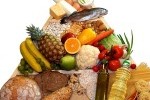Forum Replies Created
-
AuthorPosts
-
April 1, 2014 at 6:02 pm #2483
I agree that having a good relationship with food is the most important thing in maintaining a healthy weight and having a positive self image. In a study that looked at 189 nurses that were “chronic dieters” found that those that continually disregarded hunger cues and were dieters were more likely to be over-weight over their lifetime or were not able to maintain their weight loss (1). This makes sense to me because it is hard to maintain diets that are so restrictive and many end up not being able to stick to the diet.
1)Outland L, Madanat H, Rust F. Intuative eating for a healthy weight. Primary Health Care. 2013;23(9):22-28
April 1, 2014 at 5:37 pm #2482The NIH has updated their requirements for calcium intake recommendations for different ages in November of 2010. The recommendations for people ages 9-18 are 1300mg, ages 19-70 1000 mg and ages 70 or more is 1200mg. Another key nutrient in the prevention of bone loss is vitamin D. The recommendations for vitamin D are as follows: people who are between the ages of 9-70 is 600 IU and those between the ages 70 or older vitamin D increases to 800 IU (1). In one cup of milk there are about 290 mg (29% of RDA) of calcium and 127 IU (32% of RDA). Thus, one cup of milk would not be sufficient in preventing osteoporosis. These intakes are less than half of the RDA. A meta-analysis was done in 2007 and looked at the effect of calcium and vitamin D in the prevention of osteoporosis. Most of the studies that were looked at concentrated on people over 50 years old, so they required more calcium and vitamin D than younger age groups. However, the studies supported the hypothesis that calcium and vitamin D help in the prevention of osteoporosis. The studies that were included showed that there was a 54% reduced bone loss in the hip and 19% reduction in the spine. Also a positive effect on bone mineral density was found in most of the studies as well (2). Another study that looked at post-menopausal women ages 50-70, who supplemented with calcium (1000mg) and vitamin D (400 IU) had an increase of 1.06% in bone density compared to the control group that was not supplemented. Also those that supplemented had a 0.88 hazard ratio for hip fractures with a 95% confidence interval (3). Thus calcium and vitamin D have shown to be beneficial in the reduction of bone fractures and may increase bone density overall and the RDA should be met through dietary intake and maybe supplementation.
1) “Calcium and Vitamin D: Important at Every Age.” NIH Oseoperosis and Related Bone Diseases National Resource Center. N.p., n.d. Web. 1 Apr 2014. <http://www.niams.nih.gov/Health_Info/Bone/>.
2)Tang B, Eslick G, Nowson C, Smith, Bensoussan A. Use of calcium or calcium in combination with vitamin D supplementation to prevent fractures and bone loss in people aged 50 years and older: a meta-analysis. The Lancet.2007:370;657-666
3) Jackson R, LaCroix A, Gass M, et al. Calcium plus vitamin d supplementation and the risk of fractures. The New England Journal of Medicine. 2006; 354:669-683. -
AuthorPosts






